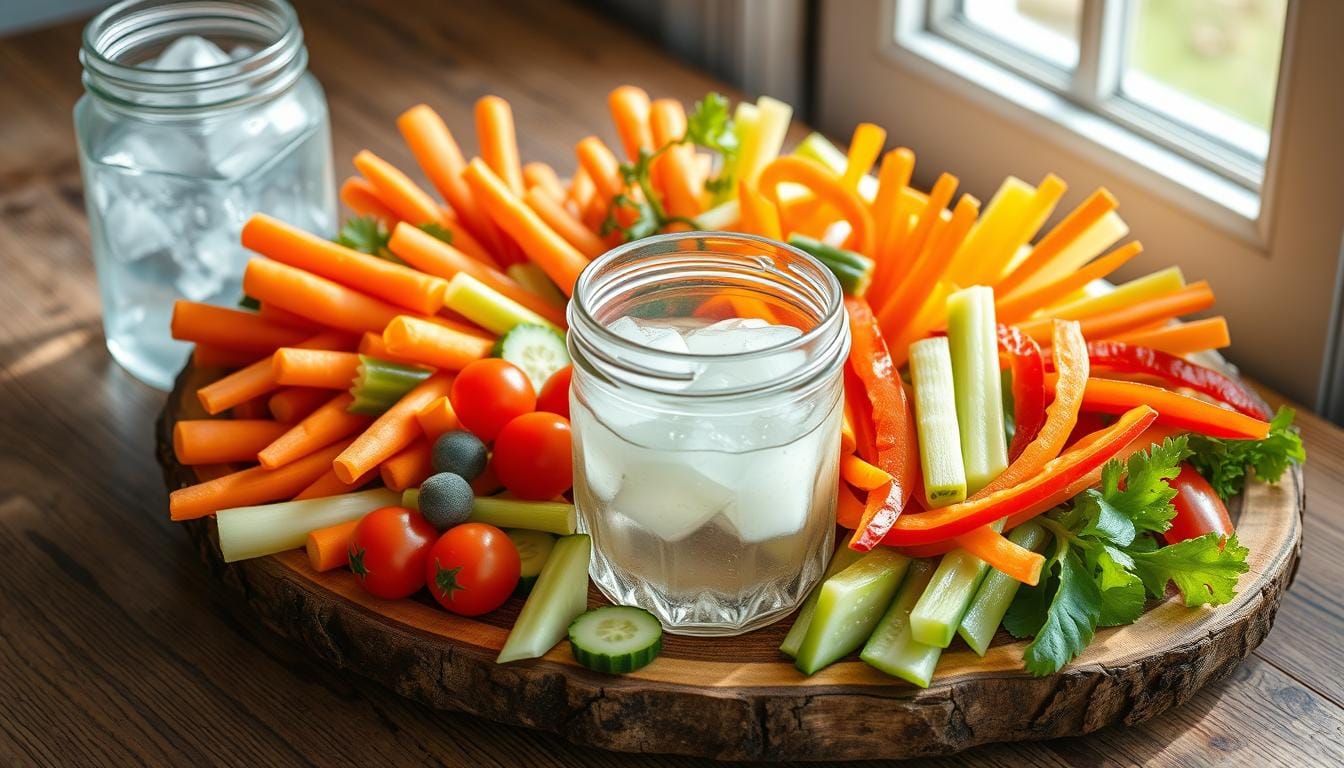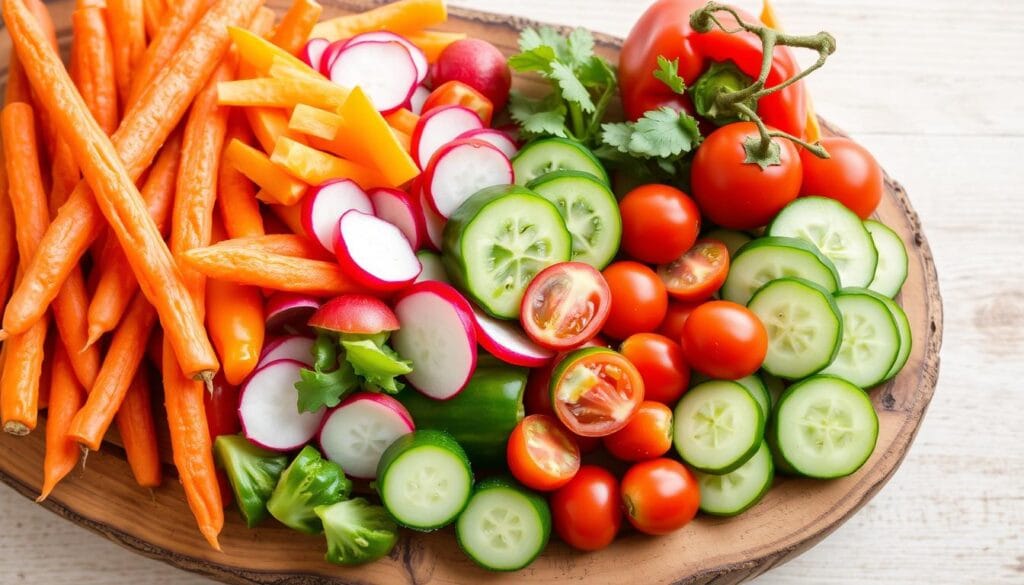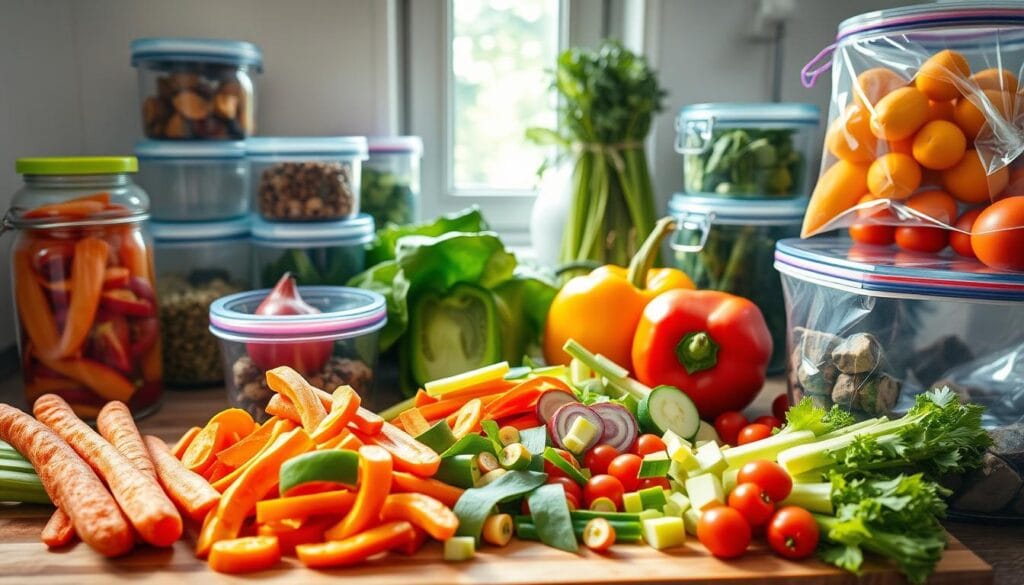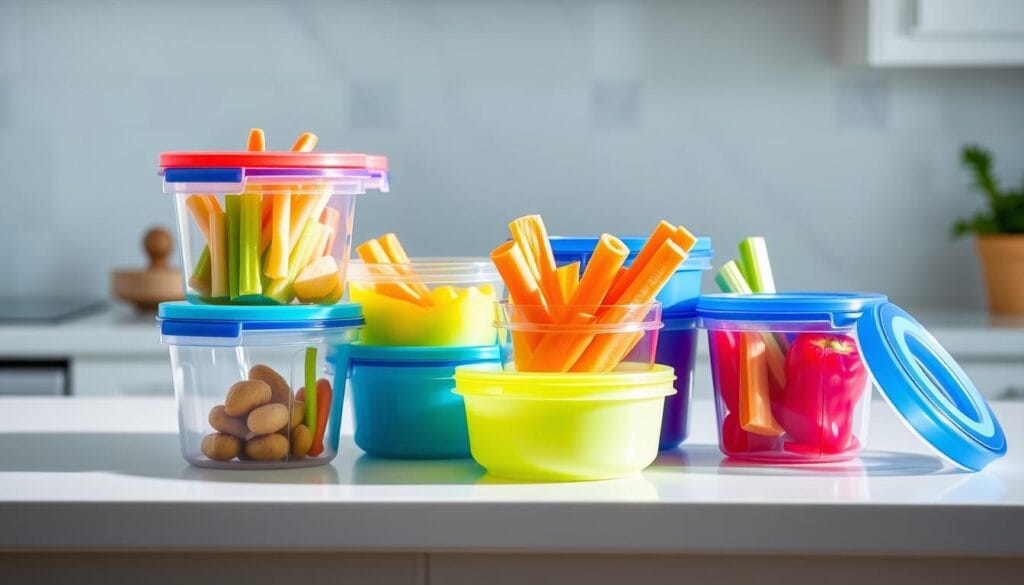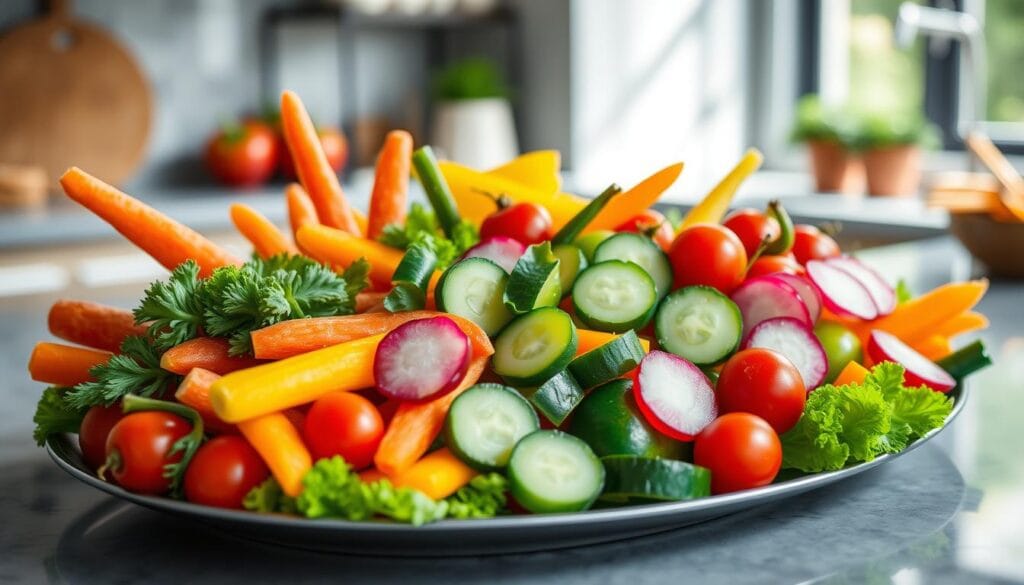As the sun sets, you’re surrounded by vibrant, crisp vegetables. They’re arranged on a platter, ready to be enjoyed. These crudités are a favorite in many homes, offering a healthy snack option. So, how to Keeping Crudités Fresh?
But, their delicate nature means they need careful attention. This ensures their freshness, reducing food waste. Let’s dive into expert tips to keep your crudités fresh, so you can enjoy them fully.
Understanding Crudités and Their Benefits
Crudités, meaning “raw vegetables” in French, are a favorite at parties. They offer a healthy snack option with lots of flavor and nutrients. They’re perfect for any event or to add more veggies to your diet.
What Are Crudités?
A crudités platter has 6-8 raw, small vegetables like snap peas and carrots. You’ll also find dips like tzatziki and hummus. Olives and pickles add extra flavor and variety.
Nutritional Advantages of Eating Fresh Vegetables
- Vegetables are full of vitamins, minerals, and fiber, offering many health benefits.
- Eating different colored vegetables gives you a wide range of nutrients, boosting your health.
- Crudités are low in calories but high in nutrients, making them a great snack choice.
Adding crudités to your diet is a smart move for a healthy snack. They’re great for parties or just to make your meals more nutritious. Crudités are tasty and good for you.
Selecting the Right Vegetables for Crudités
When making a crisp vegetable dip trays or vegetable appetizers, picking the right veggies is key. Choose a mix of crunchy, juicy, and colorful veggies for a balanced and eye-catching platter. Using seasonal produce means your dishes will taste great and be full of nutrients.
Best Choices for Crudités
- Carrots and radishes for their satisfying crunch
- Cucumbers and tomatoes for their refreshing juiciness
- Asparagus, broccoli, and cauliflower, which benefit from light blanching
- Beets, which can be served raw if baby-sized or roasted and peeled if larger
- Celery stalks, trimmed and cut into 3-inch pieces
- Snap peas, with just the stem ends trimmed
- Avocado wedges, for a creamy contrast
- Radish varieties like French Breakfast, scrubbed and wedged
Seasonal Vegetables to Consider
Using seasonal veggies makes your crudités taste better and look great. In winter, try roasted root veggies like carrots, parsnips, and beets. Spring is perfect for tender asparagus and snap peas. Summer brings juicy tomatoes, crisp cucumbers, and sweet bell peppers. Fall offers hearty options like cauliflower, broccoli, and Brussels sprouts.
Regardless of the season, a well-chosen selection of crisp vegetable dip trays and vegetable appetizers will impress your guests. By focusing on taste and looks, you’ll create a crudités platter that’s hard to resist. It’s the perfect start to a memorable meal.
Preparing Your Crudités for Storage
Getting your raw vegetable snacks ready is crucial for keeping them fresh. Before you store them, follow a few easy steps. This will help them stay crisp and colorful.
Washing and Drying Techniques
First, rinse your veggies under cool water. This removes dirt, debris, and pesticides. After washing, dry them well.
Use a clean paper towel or a salad spinner to get rid of extra moisture. This step is key to preventing spoilage and keeping your veggie tray fresh.
Cutting and Slicing Tips
For a great look, cut your veggies into uniform pieces. This makes them easy to eat and adds to the tray’s appeal. You can slice them into sticks, coins, or shapes.
Some veggies, like carrots and bell peppers, can be cut a day ahead. But for juicy items like cherry tomatoes, it’s best to halve them just before serving. This helps keep them fresh.
| Vegetable | Prep Tip |
|---|---|
| Carrots | Slice into sticks or coins up to a day in advance |
| Bell Peppers | Cut into strips or bite-sized pieces up to a day in advance |
| Cherry Tomatoes | Leave whole or halve just before serving to maintain freshness |
By following these steps, your raw vegetable snacks and veggie trays will stay fresh and look great. Your guests will love them.
Choosing the Best Storage Containers
Keeping crudités fresh and crisp is key for a great chilled veggie platter. The right containers can make a big difference. They help keep your veggies fresh for longer.
Airtight Containers vs. Ziplock Bags
Airtight containers are the top choice for storing crudités. They keep air out, which helps your veggies stay crisp. Ziplock bags are good for short storage but can trap gas that makes veggies spoil faster.
Recommended Material Types
- Glass containers: Glass is great because it doesn’t hold smells or stains. It’s easy to clean and reuse.
- High-quality plastic: Choose strong, BPA-free plastic containers. They won’t harm your food with chemicals.
- Herb storage: For fresh herbs, use small jars or glasses with water. It keeps them looking fresh like a bouquet.
Getting the right storage containers is important for a fresh veggie platter. Try out different types to find what works best for you.
The Role of Cold Storage
Storing your vegetable trays and fresh veggie platters right is key. It keeps them looking fresh and tasting great. The best fridge temperature for most veggies is between 32°F and 40°F (0°C to 4°C).
Ideal Temperature for Storing Crudités
But, not all veggies like cold storage. Fruits and veggies like tomatoes, bananas, and avocados do better at room temperature. This helps keep their special tastes and textures.
Using the Refrigerator Wisely
- Put delicate items like lettuce on the top shelf, where it’s a bit warmer.
- Harder veggies like carrots and celery go on the lower shelves, where it’s cooler.
- Don’t pack your fridge too tight. It can mess with the air flow and temperature.
Knowing the best storage spots and arranging your vegetable trays and fresh veggie platters smartly keeps them fresh. This way, your crudités stay crisp, tasty, and look good until serving time.
Utilizing Dampness for Freshness
Keeping the right amount of moisture is crucial for keeping your crudités fresh. Simple tricks like wrapping leafy greens and herbs in damp paper towels help. This creates a humid space that keeps these veggies fresh and tasty.
Using Damp Paper Towels
For greens like lettuce, spinach, and herbs, wrap them in damp paper towels. This keeps their natural moisture in, preventing them from drying out. Then, put the wrapped bundle in a sealed bag or container to keep it humid.
Moisture Control Techniques
- For cucumbers, wrap them in a clean cloth or paper towel before putting them in a plastic bag. This helps wick away any excess moisture, keeping the skins crisp and the interiors crunchy.
- Avoid sealing produce in plastic bags, as this can trap gases and lead to faster spoilage. Instead, use breathable containers or bags that allow for airflow.
- Incorporate absorbent produce pads into your airtight storage containers to help regulate moisture levels and extend the shelf life of your crudité preservation.
By controlling dampness, you can keep your vegetable platter storage fresh and vibrant. It’s perfect for a tasty snack or adding to your favorite dishes.
Long-Term Storage Solutions
While fresh is best for crisp vegetable dip trays and vegetable appetizers, there are several long-term storage options. These can help extend the shelf life of your crudités. Knowing these techniques can reduce food waste and keep your produce fresh and flavorful.
Freezing Crudités: What to Know
Freezing is a popular way for Keeping Crudités Fresh, but it needs some care. Vegetables like carrots and celery can change texture when thawed because of their high water content. To prevent this, blanching is key.
Blanching involves briefly boiling the vegetables and then cooling them in ice water. This helps keep their texture and flavor.
Pickling and Other Preservation Methods
Pickling is a great way to keep vegetables like cucumbers, carrots, and onions fresh. It adds a tangy, flavorful twist to your appetizers. Other methods, like dehydrating or fermenting, can also keep your crudités fresh for longer. However, they might change the texture and taste.
| Preservation Method | Advantages | Considerations |
|---|---|---|
| Freezing | – Extends shelf life for several months – Preserves texture and flavor with proper blanching |
– High water content in some vegetables can lead to texture changes |
| Pickling | – Adds tangy, flavorful twist to vegetables – Extends shelf life for several weeks |
– Alters the original texture and flavor profile |
| Dehydrating | – Removes moisture to extend shelf life – Concentrates flavors |
– Significantly changes the texture and mouthfeel |
| Fermenting | – Enhances beneficial gut bacteria – Extends shelf life for several weeks |
– Requires specialized equipment and knowledge |
Exploring these long-term storage solutions lets you enjoy crisp vegetable dip trays and vegetable appetizers all year. Even when fresh produce is out of season, you can still have delicious, healthy snacks.
Creative Ways to Use Leftover Crudités
Don’t let leftover raw vegetable snacks go to waste! Crudités, the fresh and vibrant veggie trays, can be repurposed in many ways. By using these nutritious ingredients in your meals and snacks, you can keep your veggie tray freshness tips alive.
Incorporating into Meals
Sauté leftover crudités in a stir-fry for a quick and flavorful dinner. Add them to omelets or frittatas for a protein-packed breakfast. Blend soft veggies like peppers or zucchini into soups and sauces for a nutrient boost.
Recipes for Fun Snacks
Get creative with your leftover veggies and make delightful snacks. Thinly slice root veggies like carrots or beets, toss in oil and seasonings, then bake until crispy for homemade vegetable chips. Marinate cucumber or carrot slices in a simple pickling solution for a tangy and crunchy treat.
For a flavorful dip, purée leftover herbs, greens, or soft veggies with olive oil, garlic, and seasonings. Serve this vibrant spread with your remaining crudités or use it as a sandwich spread.
The key to making the most of your leftover crudités is to get creative and think beyond the classic veggie tray. By using these fresh, nutritious ingredients in your meals and snacks, you can minimize food waste and enjoy the full benefits of your raw vegetable snacks.
Monitoring and Maintaining Freshness
To keep your chilled veggie platter fresh, you need to check it often. Look for any signs of spoilage in your crudités. Check for texture, color, or smell changes. If you see soft spots, mold, or sliminess, it’s time to throw them away.
To make your crudités last longer, remember a few things. Watch out for ethylene gas, which can make them spoil faster. Keep fruits that produce ethylene away from your veggies. You can also use ethylene gas absorbers in your fridge to slow down ripening.
Also, keep your fridge clean. Clean the inside with warm water and white vinegar every month. This stops bacteria from making your crudités go bad too soon.
Signs of Spoilage to Look For
- Texture changes (softening, wilting)
- Color alterations (discoloration, browning)
- Off-putting aromas
- Mold growth
- Sliminess or wetness
Tips for Extending Shelf Life
- Separate ethylene-producing fruits from ethylene-sensitive vegetables
- Use ethylene gas absorbers in produce drawers
- Clean refrigerator monthly with warm water and vinegar
By being careful and following these tips, you can keep your chilled veggie platter hacks fresh. This way, you’ll always have crunchy and vibrant crudités ready to go.
Proper Storage Locations in Your Kitchen
Storing your vegetable trays and fresh veggie platters right can keep them fresh longer. The right spots in your kitchen can make a big difference. This helps your produce stay fresh for more days.
Best Shelf Placement
Put delicate items like leafy greens and herbs on the top shelf. This shelf is cooler and better for them. Harder veggies like carrots and broccoli go on the lower shelves.
Utilizing Crisper Drawers
Crisper drawers are great for most veggies. They keep the right humidity, keeping your veggies crisp. But, keep potatoes and onions apart. Their gases can make each other spoil faster.
For counter storage, keep veggies cool and dry. This is good for items you’ll eat in two days. Don’t leave them out too long, as they’ll spoil faster.
Knowing where to store your veggies in the kitchen helps them stay fresh. This way, you can enjoy them as a healthy snack or in a tasty meal.
The Importance of Organization
Keeping your crudités fresh and long-lasting needs a smart plan. Sort your veggies by their storage needs and how they react to ethylene. This way, you protect the delicate ones and keep ethylene-producing fruits apart. It’s a simple trick that helps your crudités last longer.
Categorizing Your Crudités
Sort your veggies into groups. Low-ethylene producers like carrots and broccoli go together. High-ethylene fruits like bananas and apples are stored separately. Ethylene-sensitive items like leafy greens and berries need special care. This system helps prevent early ripening or spoilage.
Creating a Rotating System for Freshness
Use a rotating storage method to keep your crudités fresh. When restocking, put new items behind or below the old ones. Use labels to track when you bought or prepared them. This way, you can use your veggies before they go bad.
FAQ
What are crudités?
Crudités are raw vegetables arranged on a platter. They make for an easy appetizer. All you need to do is rinse and chop them.
What are the nutritional benefits of eating fresh vegetables?
Fresh veggies are packed with vitamins, minerals, and fiber. Eating a variety of colors ensures you get lots of nutrients. This boosts your health.
What are the best vegetable choices for a crudités platter?
Great choices include mini cucumbers, sweet peppers, and carrots. Snap peas, cherry tomatoes, and radishes are also good. Mix colors and textures for a nice platter.
How should crudités be prepared for storage?
Rinse veggies well and dry them off. Cut them into small, uniform pieces. This makes them easy to eat and looks good.
What type of storage containers are best for keeping crudités fresh?
Use airtight containers to keep veggies fresh. Choose containers that don’t hold odors or stains. Glass or high-quality plastic works well.
What is the ideal refrigerator temperature for storing crudités?
Store most veggies between 32°F and 40°F (0°C to 4°C). This keeps them fresh.
How can moisture be controlled to maintain the crispness of crudités?
Wrap leafy greens and herbs in damp paper towels. Store them in a plastic bag. Use absorbent pads in airtight containers to keep veggies crisp.
What are some long-term storage options for crudités?
Freezing can be tricky due to water content. Blanching before freezing helps. Pickling is great for cucumbers, carrots, and more.
How can leftover crudités be repurposed?
Add them to stir-fries, omelets, or soups. Make quick pickles or blend soft veggies into dips. Thinly slice and bake root veggies for chips.
What are the signs of spoilage in crudités?
Watch for texture, color, or smell changes. Soft spots, mold, or sliminess mean they’re spoiled.
How can crudités be stored effectively in the refrigerator?
Store delicate items on the top shelf. Use crisper drawers for most veggies. They help control humidity.
Why is it important to organize crudités in the kitchen?
Organize veggies by storage needs and ethylene sensitivity. Use a rotating system. This keeps them fresh and reduces waste.

